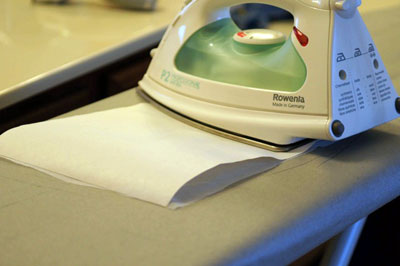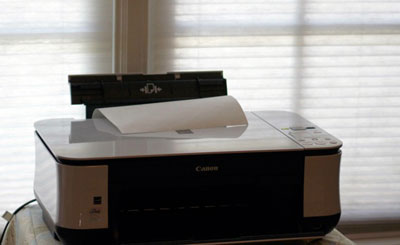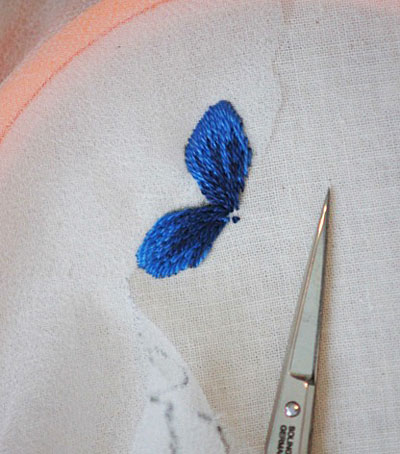A long while ago, I was looking at the book 18th Century Embroidery Techniques, and I came across the section on embroidering on velvet.

The book describes how the embroiderer would put a loose silk gauze over the velvet to hold up the stitches and provide a foundation on the velvet pile. Goldwork and embroidery worked over silk gauze placed over the ground fabric isn’t a new concept, but today’s guest writer has a great way of transferring the embroidery design to the silk gauze using an inkjet printer, so that even highly detailed designs can be transferred with accuracy. I hope you enjoy her detailed tutorial!
Hi, I’m Lisa Tressler and a big fan of Needle ‘n Thread, so I’m thrilled to be a guest today. I’d like to share a few methods that I use to transfer my drawings onto fabric in preparation for embroidering. These are particularly helpful if you have a detailed drawing that is difficult to trace well with a light box, if your fabric is too dark or thick for tracing with a light box, if you (like me) hate the prick and pounce method, or if you’re embroidering on velvet and don’t want your stitches to get lost in the nap.
I came up with this process after seeing some quilting blogs that use inkjet printers to print images as decoration on their fabric squares (Google it – there are some really nice examples), and after seeing a photo of an old piece of embroidered velvet which still had some gauze sticking out from under the edges. The gauze was used to keep the embroidery thread from sinking down into the nap of the velvet.
There are basically four steps: iron silk gauze onto freezer paper, copy or print your design onto the fabric/freezer paper using an inkjet printer, baste the gauze onto your embroidery fabric, and cut off the excess gauze after you’ve completed your embroidery. Since the gauze is lightweight and flexible, the portion under your embroidery remains for all time without causing any extra stiffness.
The nitty, gritty details are below, but first let me point out that you don’t have to use all of these steps all of the time.
If your embroidery fabric is tightly woven, 100% cotton or silk, washable and not too thick, your image is very clean (such as vector graphics) and your printer is very clean you can print directly onto the embroidery fabric/freezer paper without using gauze. You only use steps 1 and 2, using your embroidery fabric in place of the gauze. The cleanliness is to prevent stray specks showing up on your fabric.
If you don’t want to use a printer, the gauze makes tracing very easy even without a light table since it’s so thin. Just slightly tension your gauze, square it and tape the edges with masking tape to hold its shape. Place over the image and trace, then baste onto the front of your embroidery fabric. (If you’ll be washing the embroidery make sure you trace with something that won’t run.) You only use steps 3 and 4, with tracing completed in place of printing (step2).
So now for the detailed process.
Step 1. Iron silk gauze onto freezer paper.

a. Cut your silk gauze slightly larger than 8.5″ x 11″ (or whatever paper size your printer takes). The silk gauze that I use is a very fine, washable, stretchy gauze that is used for bridal veils. I get it from Jacquard Products Silk Connection. The picture below shows the cut gauze on top of the drawing I’ll be using. As you can see the gauze is almost transparent, which also makes it great for tracing.

b. Wash your gauze (or fabric) in Bubble Jet Set 2000 for 5 minutes, then let dry. This will prevent the inkjet printer inks from running. I get mine from Amazon. It is not for use in laser printers. Please follow the directions carefully and wear rubber gloves. You can find a good tutorial here. If you’re going to be using this process often, go ahead and do a whole batch of fabric.
c. Cut your freezer paper to size (8.5″ x 11″). I get mine from the local grocery store. Just make sure you get freezer paper which has wax on only one side, not wax paper which has wax on both sides.

d. Place your gauze on the ironing board, pulling into shape. Put the freezer paper on top of the gauze, with the shiny side of the freezer paper facing down toward the gauze. Press with a hot iron on the no steam setting. Press firmly without sliding the iron around. After you’re done, turn the paper over and make sure the fabric has adhered fully. If there are bubbles or the fabric isn’t adhered all the way to the edge keep pressing.

e. Trim the excess gauze from the edges of the freezer paper.
Step 2. Print image onto gauze/freezer paper using inkjet printer.
a. First, make a trial run using regular printer paper. Mark the top side of the paper with an “x” and feed it through the manual feeder. Print or copy your image, and verify that the image is the correct size, color, etc. Remember that thicker, darker pattern lines may show through light colored embroidery and light fabric, so adjust line thickness if needed. The printer can print very fine lines. Finally, note whether your printer printed on the “x” side of the paper. Once you’re happy, go on to the next step.

b. Place your gauze/freezer paper into the printer’s manual loader. Verify that the gauze is positioned so that it will be the printed side (if the “x” side was the printed side in step a, the gauze should be the top).

c. Set your printer to a thicker paper size (photo paper, card stock, etc). This helps prevent a printer jam. As you can see from the photo, I actually had my first jam working on this tutorial because I forgot this step. The ugly black marks at the edge of the paper are where the gauze/freezer paper jammed and got smudged. I just removed the gauze/freezer paper from the printer, turned it around so that I had a clean leading edge and tried again. Since the edge of the gauze will be removed later anyway, no permanent damage was done. If this had been my embroidery fabric I would have been rather upset with myself.
d. Print or copy your image.

e. Using a permanent marker (I like the micron markers), make a border on the gauze to help with alignment later (mine is 8.5″ x 8.5″). For my example, I actually made the border on the drawing I copied so it printed with my image. It’s easier later if you have a piece of paper cut to size that you use as a pattern for the border.
f. Peel the freezer paper off of the gauze.
g. Let cool for 30 minutes, then wash in cold water with Bubble Jet Rinse per manufacturers directions.
Step 3. Baste the gauze onto the embroidery fabric.

a. Mount your embroidery fabric onto its frame. Once it’s under tension, use a needle and thread to baste a border onto your stretched fabric that is the same size as the border you drew in step e above. Use your paper border pattern as a guide if you have one.
b. Place your gauze over your stretched fabric, lining up borders. Baste the gauze onto your fabric along the border. This ensures that your image is not distorted.
c. Embroider as you normally would, right through the gauze.
Note: My big frame is currently in use, so I couldn’t mount my fabric and complete this step. The picture above shows the printed gauze resting on the embroidery fabric so you get an idea of how well you can see the image.
Step 4. Remove the gauze

a. After your embroidery is complete, remove the basting stitches that held the gauze to your embroidery fabric. Using very sharp embroidery scissors and some patience cut the gauze away from the perimeter of the embroidery. Since the gauze has some stretch to it I like to pull on it gently as I cut. This pulls the gauze slightly out from under the embroidery so you get a nice clean edge.

I went ahead and made a sample embroidery on a scrap of fabric and gauze so that you can see how well the thread goes through the gauze, and how it looks after removing the gauze. The thread is a single strand of Soie d’Alger, and the fabric is muslin.

And that’s all there is to it. I hope this comes in handy the next time you have a difficult transfer to complete. Do you have any other transfer methods to recommend?







G’day Mary and Lisa,
This has answered quite a few questions and wonderings I’ve had about these things.
And, it’s also answered others that I hadn’t thought of yet!
Excellent tutorial. Thanks heaps.
Cheers, Kath.
It is amazing how the same idea float around the world at the same time! My last blogpost (posted last sunday) is about this exact same thing. I used embroidery stabilizer instead of gauze but otherwise the principle is the same. I came up with the idea on my own – didn’t know it was around in the 18th century (without printer of course)!
Dear Mary!
Thanks for this tutorial!! It is exactly what I have been looking for, for embroidering my son’s stoles which are not easy to draw a design upon. I will certainly keep this bookmarked and use it when I am ready to start! Love your blog and read it daitly!
Linda
What a great idea! Definitely a keeper. And it has the added benefit of keeping your embroidery clean around the edges of the hoop. Thanks for the tip, will you publish it as a pdf for easier downloading and printing?
good monrning Mary, may I share this post and pictures in my blog http://www.todalatela.blogspot.com (with a little Spanish translation and credits to your blog) please?
Mariel
Hi, Mariel – You’re welcome to translate parts of the article and refer your readers to it on my website. Thanks for asking! However, the whole content of the article and the pictures actually belong to the author, so it is up to her whether or not she wants the pictures / content entirely transferred to your website. But some translation and a reference to the original article for pictures, etc., is perfectly fine! Thanks for understanding! MC
At first, when you spoke of silk gauze, I thought of the expensive sorta-stiff stuff used for mini-needlepoint (doll house rugs, etc.) and couldn’t imagine using it that way. When you said “bridal veil” it all came clear!!! My most-used method of design transfer is tracing on tissue, basting the design onto the fabric, and ripping away the tissue. This method doesn’t work very well for (a) extremely detailed designs or (b) on velvet. Thanks Lisa for the wealth of detailed information!
Fantastic technique! Can’t wait to try it because I’m definitely a card carrying member of the the Anti- P&P League (prick and pounce) when it comes to transferring my designs! 🙂
Claire
Try Transfer-eze. It goes through the printer–no prep–no scary trimming–just rinse it out when you are done stitching. You can read about it here:
http://zuill.us/andreablog/2010/01/29/transfer-eze-a-new-product-for-embroiderers/
I work in a quilt shop and have had rave reviews from customers.
LOVE this technique AND the tutorial. I’m off to try it on velvet!! Thanks loads to you Lisa AND to Mary…woohooo!!!
I use Transfer Eze and it looks to be so much better than this. I haven’t tried it on napped fabric yet. I works fine on the 100% linen I use. I have frogged out stitching many times and the pattern is still clear. You just print the pattern, peel off the backing and stick it on your fabric. When you are done soak your project in cool water (I put in a little Dawn) and the Transfer Eze disappears completely.
Thanks very much! I am about to embark on a project that involves very intricate designs on black velvet and have been wondering how to transfer the design….
Hi everyone. I love your suggestions about the Transfer Eze, I’ll definitely try it on my next washable project. And Mariel, you’re welcome to use the post and photos along with your translations, so long as you credit both Mary and I.
Mary, I’d really like to try this (maybe Jane Nicholas’ bugs on Mary Jo Hiney’s velvet?), but since this blog was written in 2010, the recommended source for the appropriate silk gauze no longer exists. When I google silk gauze, there are a zillion possibilities/different kinds of silk gauze. I’m wondering if you could add a header line to this article with an updated source for the correct stuff? Thanks so much!